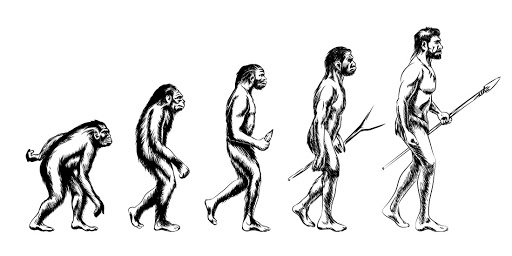Question 1: According to the theory of evolution by Darwin, a living entity adapts itself to the environment in which it lives. (eg A zebra turning into giraffe by elongating its neck). Logically it’s perfectly right. Darwin’s theory says for scarcity of food on the ground, the giraffes had to extend their necks to get food from the tree tops. But deer, antelopes and other herbivores were eating from the ground anyways. So is it logically perfectly right to say that zebra had to become a giraffe? In nature we see so many examples. Someone living in cold countries develops white body while someone living in hot climates develops black body. People of different countries have different bodily features due to climatic conditions.
Answer by Romapada Swami: The hinge of these arguments is that adaptation results from chance. Let’s see how valid this explanation is. (What follows is the result of assistance provided by a scientist devotee.)
Skin color comes from special cellular organelles called melanosomes. The difference in skin color of different races comes because of differential pigment synthesis. The synthesis begins from tyrosine -> DOPA -> dopaquinone. At this point the pathway branches and dopaquinone either reacts with cysteine to produce pheomelanin or it is converted to leucodopachrome to produce eumelanin (there are some intermediate steps before the specific melanin is produced). So the point is the change in body color cannot just come because of temperature. This is not to say that change in temperature does not affect the body color but is not sufficient enough to cause generation of totally different race/ethnicity. Furthermore, it’s not only the skin color that is different between the races but also bodily features (as you have correctly pointed out) and each characteristic that we mention may it be skin color or something else has to result from some elegant biochemistry. And if you study these different biochemical processes (a couple I have mentioned above on melanin biogenesis), they are irreducibly complex and tightly controlled by precise biochemical and biophysical parameters. What is the probability that these will just result from a chance?
Question 2: Appendix (part of body) was used by primitive people to digest hard foodstuffs. But now as it is not used it is led invaluable and can be removed without any loss.
Answer: Whatever science says has to be accepted with a grain of salt as it is dependant on information gathered from our imperfect senses and hence is far from perfect. This case of appendix is an excellent example. The supposed “uselessness” of appendix is one of the controversial subject matters in human physiology. There are some schools that hypothesize that the appendix has lymphatic, endocrine, exocrine and neuromuscular functions and there are others who disagree with this view. Thus we cannot use appendix as a case to defend evolution. Let us await what science has to say about the appendix in the future. It should not come as a surprise to us that scientists are not able to ascribe some function to the appendix as they did it with the pineal gland that was once considered a “vestigial remnant of evolution”.
I beg to correct you on the primitive function of the appendix that you have mentioned: the human appendix is considered as a vestigial organ of larger cellulose-digesting cecum that was used by the herbivore ancestors and not used by primitive people to digest hard foodstuffs.
Question 3: Mosquitoes develop immunity to mosquito repellent chemicals after some period of time. So this proves the living entity adapts itself to its environment.
Answer: The body’s adaption capacity (some call this ‘micro-evolution’) is not a contradiction to the Vedic model by any means. Certain changes “within” the species that increase its fitness are certainly observed within a population. Antibiotic resistance is another example. However, what Darwinian evolution talks about is generating a totally new species, which is not acceptable. There have been veritably millions of mutagenesis experiments done on Drosophila but there has been never been a case when a house-fly or some other species developed from a fruit-fly. There has never been a case when a human gave birth to a monkey or vice-versa. Like begets like.
Question 4: So why can’t monkeys turn into human beings due to adaptability?
Answer: I again would like to correct you that the Theory of Evolution does not say that monkeys became human beings. As per Theory of Evolution, humans, apes, monkeys and other “look-alikes” descend from a common ancestor.
On a concluding note, the proposed Theory of Evolution is not so simplistic that “something adapts itself”. With the advent of molecular biology, the theory is becoming more complex and is seeking its justification at the DNA and protein level. Changes in allele frequencies, genome duplications, orthology, paralogy and similar other observations are being used to substantiate its credibility. But Evolution is far from being “proved”. Moreover, as devotees we are more concerned with the atheistic foundation and subsequent implications of ToE rather than the theory itself. This was also one of the reasons that Darwin did not publish his findings until very late even though he had compiled them much earlier.







